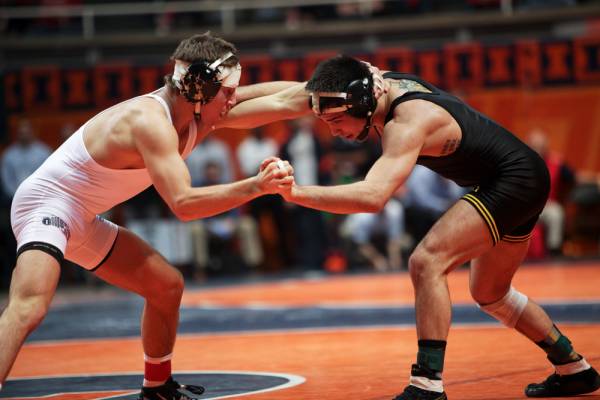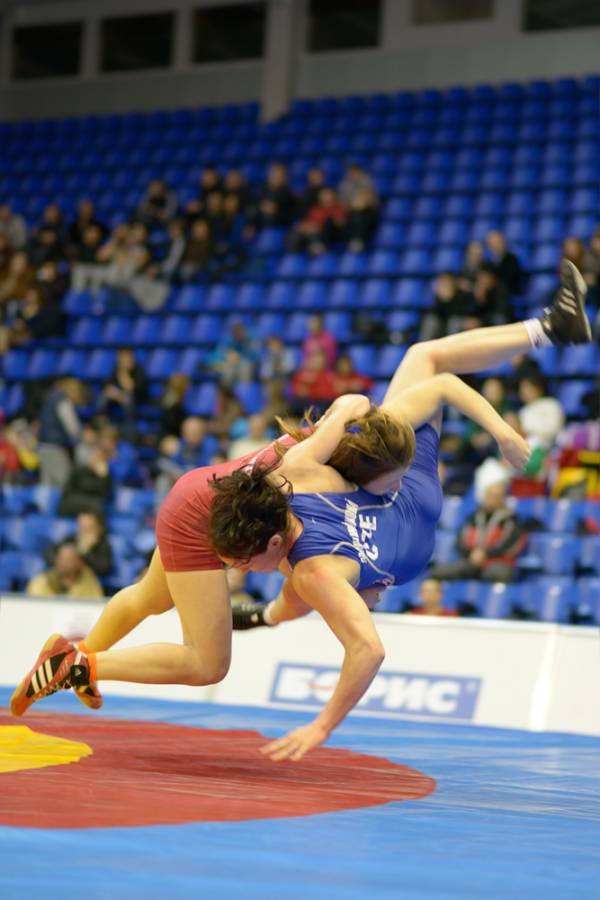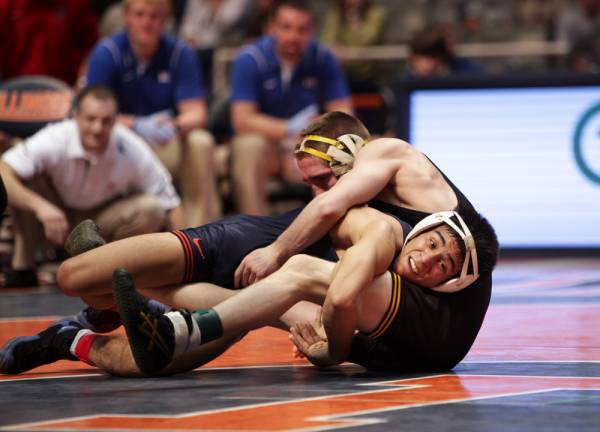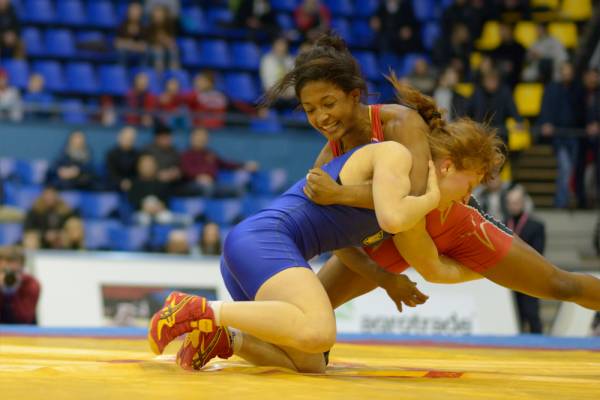Historically, submission grapplers as a group have been reluctant to invest in learning even the rudiments of wrestling, even though it is clear that many of its fundamental principles and concepts could help us with our grappling. What is it that prompts this reluctance? Is it balkanization? Fear of the unknown? Ego? Laziness? Perhaps it’s some of each. The important takeaway, however, is that we submission grapplers downplay or even outright ignore the potential benefits of wrestling at our own peril.
I had the opportunity to speak with Dave Jacobs and Brendan Raedy (pictured belowed), both Brazilian jiu jitsu black belts and high school and D1 collegiate wrestlers, to get their expert opinions on the application of wrestling to BJJ. Dave and Brendan are instructors at Dave “The Rock” Jacobs BJJ in Vienna, Virginia. Our lively discussion resulted in the articulation of four significant benefits even the most dedicated butt-floppers can derive from the application of wrestling concepts to their grappling game.
Benefit #1: Strategic Use of Power and Intensity
Wrestlers as a rule are relentless and, if they could, they would fight for position beyond the point of unconsciousness. When wrestlers first come to a BJJ academy, old-timer grapplers can sometimes become annoyed at their tendency to treat every roll as a steel-cage death match. But as Dave pointed out, there really aren’t any casual practitioner collegiate wrestlers who are there “just to get in shape and have a good time.” The atmosphere of a wrestling practice can be far more charged than the laid-back energy of an evening BJJ practice, which may be populated by adult students who have just put in a full day of work rather than full-time students in the prime of their athletic lives.
That being said, Brendan observed, although BJJ has historically been touted as a discipline wherein the small guy can beat the big guy on the basis of technique alone, this is only true when the big guy doesn’t know any technique. When technique is equal, what wins matches is better conditioning and mental toughness, which are de rigeur in wrestling sessions.
This is not to say that all grapplers have a laissez-faire attitude about grappling. Witness the increased focus on strength and conditioning in recent years among professional-level BJJ competitors. But as a class, grapplers are still pretty far behind wrestlers in terms of simply expecting that pushing outside yourown comfort zone is part and parcel of the training experience.
Now, lest you protest that you are one of those grapplers who just trains to have fun and stay in shape, so the intensity factor is irrelevant to you, according to Dave and Brendan there is a place for increased intensity in your practice as well. Lower belts and casual enthusiasts don’t have to push themselves to the same extent as grappling professionals, Dave commented, but we can all identify our own comfort zones, both physically and mentally, and commit to pushing ourselves outside of them on a regular basis. This is how we grow as athletes and as people. As Brendan observed, an effective way to do this is for each individual to be competitive with him- or herself, rather than with others. Each grappler can focus on daily victories – did I tap only nine times today where yesterday I tapped ten times, for instance – which is something wrestling focuses on as well. Your instructor can help you target your efforts to maximize your effectiveness at pushing yourself enough to progress, but not so much that you lose interest or become discouraged.
Benefit #2: Enhancement of the Familiar
As a rule, most grapplers are more comfortable rolling around than we are engaging with someone on the feet. We pride ourselves on knowing what to do when a fight goes to the ground. (Let’s set aside for the moment how useful it would be to be able to get someone to the ground who does not want to go there.) Though it may change over time, many grapplers have a go-to game of some kind – a sure-thing half-guard pass, or a real comfort level in seated guard. According to Dave and Brendan, there are many potential enhancements to your favorite positions that are rooted in wrestling if you are willing to look for them. Take the single leg takedown from half guard, the arm drag, and the switch, to name a few. These are all effective movements for grappling, and they are wrestling 101.

According to Brendan, another thing we grapplers can learn from wrestlers and wrestling that could enhance our understanding of what is already familiar is the importance of learning the rules of our sport. Generally speaking, wrestlers and wrestling coaches have a sophisticated understanding of the rules of wrestling. Grapplers and grappling coaches, on the other hand, tend not to be as diligent in their study, which can adversely affect competition performance and strategy. And again, even if you don’t plan on competing, chances are you like to watch competition. Knowing the rules will help you be a better armchair quarterback, able to amaze and annoy your friends.
Benefit #3 : Takedowns – They’re More Than Just Takedowns
Takedowns areusually what grapplers think of when they think of wrestling. The holes in our grappling game that wrestling might help us fill are frequently distilled down to this one word. And as implied above, if we want to ply our ground game, we have to be able to get to the ground, which isn’t easy against a resisting opponent. As Brendan observed, witness the likes of Chuck Liddell, who during his UFC career would simply get right back up again on those few occasions when an opponent was able to unbalance him. Dave commented on the fact that in wrestling and in judo, everyone does takedowns, no matter what size, body shape, or level of fitness. No one is not a “takedown person.” And even a rudimentary understanding of takedowns could spell the difference between a win and a referee’s decision in a tournament – how many times have you seen a match that was decided by the two points awarded for the person who brought the game to the mat?

Brendan and Dave are adamant that the relative lack of sophistication with takedowns is a huge hole in the typical grappler’s repertoire. And to those people who say they don’t want to drill takedowns because they find them dangerous, Brendan would pose the following question: If you don’t trust someone to deliver you safely to the mat, is it really wise for you to trust them to be able to apply a kimura safely? Along those lines, Dave and Brendan stated that in kids’ tournaments, competitors are frequently not allowed to do submissions but they areallowed to do takedowns. So, the safety question is relative. And the follow-up question would be: Are you really concerned about your safety, or do you just recognize that drilling takedowns requires a higher level of fitness and effort? The energy demands of even ten minutes of takedown work can be surprising to those of us who don’t spend a lot of time on the feet.
Now, Dave and Brendan can hear some of you saying that you will never compete, so you don’t need to work on takedowns. As you might imagine, they have a response to that as well, which is that drilling takedowns isn’t just about unbalancing someone. It is also about increasing body awareness by learning how to fall safely. It is also about enhancing the grappler’s technical and strategic knowledge by enabling him or her to chain movements together from the start of a sequence. It taps into philosophical and contextual knowledge about grappling in general that, according to Brendan, doesn’t start or stop depending on whether someone has a knee on the mat.

Further, as Dave observed, if you decide not to learn takedowns, you won’t go to grappling jail, but you will be short-changing your experience and knowledge of the grappling scene. You will basically be proclaiming to the world that you are unwilling to be a complete grappler. Finally as Brendan observed, you will also miss out on an opportunity to improve your guard pulling. Dave is not an opponent of guard pulling (and has pulled guard) in tournaments, but there is technique to it as well and a takedown game can help with that by giving grapplers more opportunity to experience and capitalize on actions and reactions.
Benefit #4: Tournament Preparation and Recovery
Much like with the intensity factor, high-level competitors have in recent years started to become more planful about their training, strategizing so they peak both mentally and physically right before big tournaments such as the Mundials. But Dave and Brendan still find that students will come to them in the week before a tournament and say, “The competition is on Saturday. What can I do to prepare?” The answer at that point is, sadly, not much. If you come to the professor the night before the exam and ask how you can be successful, the answer is going to be: “Get some sleep and hope for the best.” Back in the day, grapplers might have been able to simply jump into a competition at the last minute and do well, but increasingly, anyone who wants to be seriously competitive must start planning and preparing months in advance, which is something wrestlers have been doing for decades.

While there may not be as clear a season in BJJ as there is in wrestling, it is still important for grapplers to work with their coaches to build a training program around their goals that accounts for the different needs of off-season, pre-season, peak season, and post-season training. Importantly, according to Brendan and Dave, peak season training in wrestling does not consist of hours of grinding, full-bore activity. Rather, each subsequent training session leading up to a competition is a bit shorter, so that by the time you get to post-season, practices have routinely lasted for perhaps thirty minutes and no more. And note the concept of post-season: if eighteen-year-olds need some time off, older adults with adult responsibilities surely will as well.
Wrestling and submission grappling are related but distinct activities. If we grapplers wanted to be wrestlers, we would pursue wrestling. That being said, there are compelling arguments for grapplers to incorporate skills, concepts, and habits of mind into their practice that are traditionally associated with wrestling. As the elder statesman, wrestling features traditions and accumulated wisdom that predates that of BJJ, the up-and-comer. So, to round out your grappling game, take a tip from Dave and Brendan. Better still, pay them a visit at The Rock BJJ, and let them help you bring out your inner Dan Gable.
Photos 2-5 courtesy of Shutterstock.






